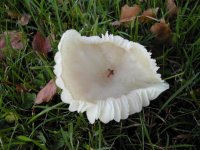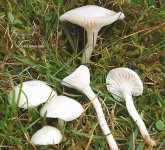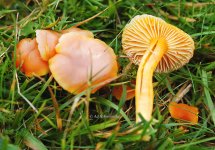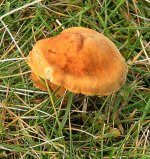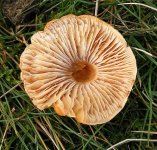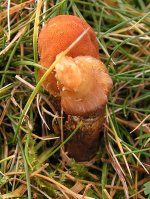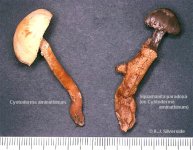-
Welcome to BirdForum, the internet's largest birding community with thousands of members from all over the world. The forums are dedicated to wild birds, birding, binoculars and equipment and all that goes with it.
Please register for an account to take part in the discussions in the forum, post your pictures in the gallery and more.
You are using an out of date browser. It may not display this or other websites correctly.
You should upgrade or use an alternative browser.
You should upgrade or use an alternative browser.
Unknown Fungus (1 Viewer)
- Thread starter cjay
- Start date
More options
Who Replied?psilo
Well-known member
colinj said:Sent to me from essex. Does anyone know what this one is?
Colin J
errrr no Im not even going to attempt this one! lol but I would be interested in knowing cos I have one that is very similar that is orange/brown
Silver
Registered Sane
colinj said:Sent to me from essex. Does anyone know what this one is?
Colin J
LOL, I know this one a bit too well at the moment, having been going out 2-3 times a week to monitor it and its relatives.
It is a Snowy Wax-cap, Hygrocybe virginea (aka H. nivea). Late season grassland fungi in 'unimproved' pastures - most are some shade of bright yellow, orange or red but H. virginea is "virginal" white.
It is quite common, even on lawns, but it is always worth scouting around for its relatives whenever it is seen. Find a site with more than, say, 20 Hygrocybe species and there will be people who will be very interested!
Alan
psilo
Well-known member
Silver said:LOL, I know this one a bit too well at the moment, having been going out 2-3 times a week to monitor it and its relatives.
It is a Snowy Wax-cap, Hygrocybe virginea (aka H. nivea). Late season grassland fungi in 'unimproved' pastures - most are some shade of bright yellow, orange or red but H. virginea is "virginal" white.
It is quite common, even on lawns, but it is always worth scouting around for its relatives whenever it is seen. Find a site with more than, say, 20 Hygrocybe species and there will be people who will be very interested!
Alan
ooohh very interesting. I have seen quite a few orange coloured fungi with that similar looking open gill structure. what is the interest in this one then Alan? and why are you monitoring it?
Silver
Registered Sane
psilo said:ooohh very interesting. I have seen quite a few orange coloured fungi with that similar looking open gill structure. what is the interest in this one then Alan? and why are you monitoring it?
I can best explain about "waxcap grasslands" by putting in a link to one of my own webpages.
http://www-biol.paisley.ac.uk/bioref/Habitats/WCGrassland.html
It badly needs updating but it gives a general summary.
I currently have a project student working on a very good local site (now about 30 Hygrocybe species if we group two adjacent sites together, based on records from the past 10 years) - looking at other aspects of the site but also keeping a record of the fungal fruiting in a number of fixed quadrats. (And bloody freezing it was up there today!)
If this works, I am going to try posting one of my own photographs of Hygrocybe virginea ......
Attachments
psilo
Well-known member
Interesting article that Alan. We have quite alot of similar grassland in our area that is rich in fungi. Sheep graze it and because it is rocky and uneven it is not intensely farmed. It is also very damp. Whilst up there I have found a number of fungi though naturally I dont have any names for them as yet, but I am still looking  The commonest one that is there is an orangeone that I thought might be a waxcap but now I have my doubts. Whilst it has the open gill structure and is bright orange it doesnt have the slippery look to the cap that i have seen in waxcap photos. It also seems to have a faintly grooved cap margin that goes in slightly too. Looks like it is back to the reference books for me lol!
The commonest one that is there is an orangeone that I thought might be a waxcap but now I have my doubts. Whilst it has the open gill structure and is bright orange it doesnt have the slippery look to the cap that i have seen in waxcap photos. It also seems to have a faintly grooved cap margin that goes in slightly too. Looks like it is back to the reference books for me lol!
Silver
Registered Sane
psilo said:Interesting article that Alan. We have quite alot of similar grassland in our area that is rich in fungi. Sheep graze it and because it is rocky and uneven it is not intensely farmed. It is also very damp. Whilst up there I have found a number of fungi though naturally I dont have any names for them as yet, but I am still lookingThe commonest one that is there is an orangeone that I thought might be a waxcap but now I have my doubts. Whilst it has the open gill structure and is bright orange it doesnt have the slippery look to the cap that i have seen in waxcap photos. It also seems to have a faintly grooved cap margin that goes in slightly too. Looks like it is back to the reference books for me lol!
Psilo, your orange fungus is quite likely to be a waxcap. Some have slimy caps, some have dry caps, some are grooved at the margin, some tend not to be.
They are not easy to identify though. There are quite a few orange species that generally need to be confirmed by microscopic characters - structure of the cap and stem surfaces as well as spore characters. Also, several of the usually yellow species have orange varieties and red species can fade to orange. Basically, they need to be identified from specialist literature - the general fungus books give only a limited selection and don't take account of the variation in each species.
Since I have now learnt how to post pictures, here is one of the more common orange species. It is Hygrocybe quieta, characterised in the field by its "washed out" look as the cap matures and by its oily "bedbugs" smell, exactly the same as in the well known milkcap, Lactarius quietus.
Alan
Attachments
psilo
Well-known member
Silver said:Psilo, your orange fungus is quite likely to be a waxcap. Some have slimy caps, some have dry caps, some are grooved at the margin, some tend not to be.
They are not easy to identify though. There are quite a few orange species that generally need to be confirmed by microscopic characters - structure of the cap and stem surfaces as well as spore characters. Also, several of the usually yellow species have orange varieties and red species can fade to orange. Basically, they need to be identified from specialist literature - the general fungus books give only a limited selection and don't take account of the variation in each species.
Since I have now learnt how to post pictures, here is one of the more common orange species. It is Hygrocybe quieta, characterised in the field by its "washed out" look as the cap matures and by its oily "bedbugs" smell, exactly the same as in the well known milkcap, Lactarius quietus.
Alan
Alan here are some photos of the orange fungi found as described above. The cap is approx 4cms across and the height approx 4cms too. Do you think this is a waxcap?
Attachments
Silver
Registered Sane
psilo said:Alan here are some photos of the orange fungi found as described above. The cap is approx 4cms across and the height approx 4cms too. Do you think this is a waxcap?
No Psilo, you are right after all, this is not a wax cap.
I am fairly certain that it is Cystoderma amianthinum - a common species in base-poor grassland and often plentiful in wax-cap grasslands.
Commonly it is a paler yellow than your photograph, but frequently too it is this rich rust colour (and can be a darker brown but then needs to have its spores measured to separate it from another, very closely related species).
When young and fresh, the surface of the cap is covered with a fine powder of loose, rounded cells and there are white flakes on the stem, but these are easily lost with age or rain (or handling by students!).
What is puzzling is your photo number two. Something very peculiar seems to be happening to the fruitbody in the foreground. I assume it is too late for you to go back and see what developed?
The reason I ask is that Cystoderma amianthinum is the host to another toadstool that takes over the young fruitbody and emerges (a bit 'Alien' like) from the malformed stem. This parasite is Squamanita paradoxa, apparently exceedingly rare, since it has been reported only on a handful of occasions, anytime, anywhere. However, it turned up a few years ago in the waxcap grassland that we have been using in our student sampling exercise, and it was also found in Wales and in England in the same week. There had been prolongued rain over many days and Cystoderma itself was present in thousands.
I'm attaching a photograph, but both fungi in the picture are well past their best and were handled by students. Also the scan hasn't really picked up the violet colour of the Squamanita.
I am NOT saying that the malformation in your photo is developing Squamanita - there is no sign of any violet colour and, as I have said, it is exceedingly rare. But it's intriguing ......
Attachments
psilo
Well-known member
Silver said:No Psilo, you are right after all, this is not a wax cap.
I am fairly certain that it is Cystoderma amianthinum - a common species in base-poor grassland and often plentiful in wax-cap grasslands.
Commonly it is a paler yellow than your photograph, but frequently too it is this rich rust colour (and can be a darker brown but then needs to have its spores measured to separate it from another, very closely related species).
When young and fresh, the surface of the cap is covered with a fine powder of loose, rounded cells and there are white flakes on the stem, but these are easily lost with age or rain (or handling by students!).
What is puzzling is your photo number two. Something very peculiar seems to be happening to the fruitbody in the foreground. I assume it is too late for you to go back and see what developed?
The reason I ask is that Cystoderma amianthinum is the host to another toadstool that takes over the young fruitbody and emerges (a bit 'Alien' like) from the malformed stem. This parasite is Squamanita paradoxa, apparently exceedingly rare, since it has been reported only on a handful of occasions, anytime, anywhere. However, it turned up a few years ago in the waxcap grassland that we have been using in our student sampling exercise, and it was also found in Wales and in England in the same week. There had been prolongued rain over many days and Cystoderma itself was present in thousands.
I'm attaching a photograph, but both fungi in the picture are well past their best and were handled by students. Also the scan hasn't really picked up the violet colour of the Squamanita.
I am NOT saying that the malformation in your photo is developing Squamanita - there is no sign of any violet colour and, as I have said, it is exceedingly rare. But it's intriguing ......
Oh my thanks Alan! its seems that although my identifying skills arent brilliant I am learning to decifer what things they are not!
This species is not listed in my book and I have been looking it up on the net. This species is another prime example of a species with so much variation. Obviously the cap colour varies but on this one the stem and gill colour seems to be vary too so how on earth do you know that you have the same thing?
psilo
Well-known member
regarding the second photo. All it is showing is the stem. The cap photographed in photo 2 and 3 has just been removed from the stem and I think that maybe part of the cap has been left behind?
your photo showing the parasitic fungi is absolutely fascinating. I am glad that youve learnt to post them
actually I have an editing query for anyone. I cant seem to figure out how to send a reply with only a part of a quote being highlighted and not the whole quote.
Many thanks
your photo showing the parasitic fungi is absolutely fascinating. I am glad that youve learnt to post them
actually I have an editing query for anyone. I cant seem to figure out how to send a reply with only a part of a quote being highlighted and not the whole quote.
Many thanks
[/QUOTE]
actually I have an editing query for anyone. I cant seem to figure out how to send a reply with only a part of a quote being highlighted and not the whole quote.
Many thanks[/QUOTE]
Hi,
I use the "reply" button on the comment that I wish to reply to. This shows the text of the comment and I simply delete that which I don't want to show. Hopefully, this comment will show only that part of your comment refering to the editing query. Obviously if it doesn't then it's best to ignore this reply!
Sonia
actually I have an editing query for anyone. I cant seem to figure out how to send a reply with only a part of a quote being highlighted and not the whole quote.
Many thanks[/QUOTE]
Hi,
I use the "reply" button on the comment that I wish to reply to. This shows the text of the comment and I simply delete that which I don't want to show. Hopefully, this comment will show only that part of your comment refering to the editing query. Obviously if it doesn't then it's best to ignore this reply!
Sonia
Silver
Registered Sane
psilo said:regarding the second photo. All it is showing is the stem. The cap photographed in photo 2 and 3 has just been removed from the stem and I think that maybe part of the cap has been left behind?
Ah!
yes, that makes sense now!
Incidentally, as you say, C. amianthinum is very variable (it's a sort of "deciever" of grasslands), but there are related species of course. Your second photo, now I understand what it shows, does seem to have a very robust stem and a rather coarsely granular cap surface and in a wooded habitat I would have been thinking about one or two other species. However, I do remain confident that they are all C. amianthinum. I have had to check out quite a few 'odd' ones this year!
Alan
Silver said:Ah!
yes, that makes sense now!
Incidentally, as you say, C. amianthinum is very variable (it's a sort of "deciever" of grasslands), but there are related species of course. Your second photo, now I understand what it shows, does seem to have a very robust stem and a rather coarsely granular cap surface and in a wooded habitat I would have been thinking about one or two other species. However, I do remain confident that they are all C. amianthinum. I have had to check out quite a few 'odd' ones this year!
Alan
Psilo: If it's any consolation to you, I failed to id the red species. Only when Alan suggested C amianthinum did I realise what it was, even though I have seen numerous specimens this Autumn!
psilo
Well-known member
LOL Leif! I find the variations totally confusing, as I learn more I am beginning to realise just what a mine field I am walking into. It is an interest that is almost infinate in what you can learn. I think for me at the moment learning to know what something is not is as important as what it might be as there are so many species to go at. I have alot of photos of fungi that I have found in my local area in recent weeks, there certainly isnt a shortage of material and I am having a ball!! it would I guess be all too easy to post them all on here and say what are these please? but then where would the fun be in that? having said that I do have quite a few that have got me completely stumped so I might just relent lol!!
Silver
Registered Sane
Silver said:Cystoderma amianthinum is the host to another toadstool that takes over the young fruitbody and emerges (a bit 'Alien' like) from the malformed stem. This parasite is Squamanita paradoxa, apparently exceedingly rare, since it has been reported only on a handful of occasions, anytime, anywhere. However, it turned up a few years ago in the waxcap grassland that we have been using in our student sampling exercise, and it was also found in Wales and in England in the same week. There had been prolongued rain over many days and Cystoderma itself was present in thousands.
An update to this - I have just heard that Squamanita paradoxa has been around this year - in two places at least. Worth looking out for wherever there is still a good population of Cystoderma still fruiting.
Alan
Silver
Registered Sane
psilo said:maybe it is worth taking a walk up in the hills were I found these ones then but then with all the rain we have been having lately the paths may be impassable as they can be difficult going at best. Do they only grow out of the ones that have their cap removed alan?
No, Squamanita simply takes over so that its cap appears rather than that of the Cystoderma. The effect is weird, the Squamanita looks like it has been grafted on to the original stem.
Alan
psilo
Well-known member
Silver said:No, Squamanita simply takes over so that its cap appears rather than that of the Cystoderma. The effect is weird, the Squamanita looks like it has been grafted on to the original stem.
Alan
Oh right! wow! now that is wierd. I will definatly keep my eyes open for those then.
Similar threads
Users who are viewing this thread
Total: 2 (members: 0, guests: 2)




